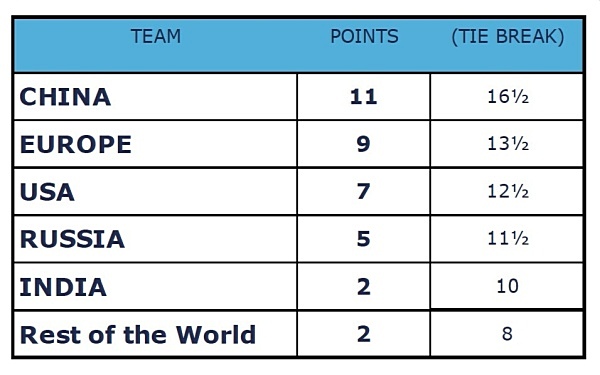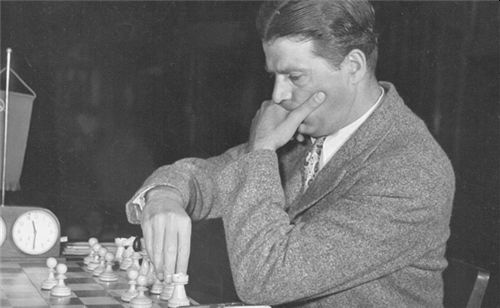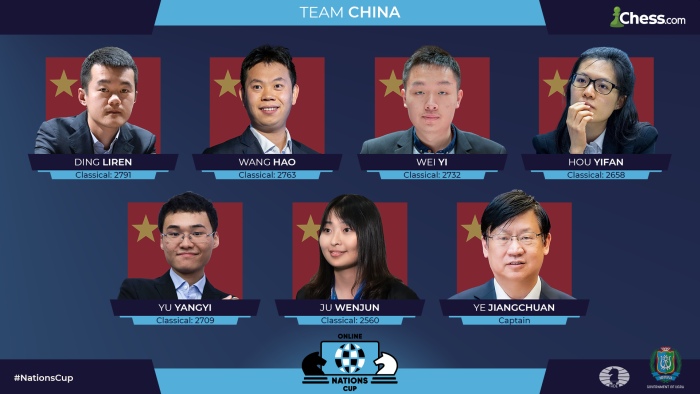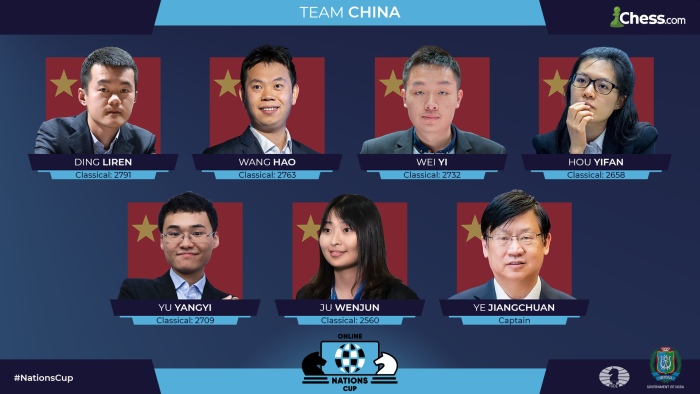Over four million moves and €10,000 raised in a charity marathon

The French Chess Federation liaised with the Fondation de France to fights the coronavirus and organized 24-hour chess marathon in cooperation with Lichess, Blitzstream, Europe-Echecs, Chess24, Variantes, and Apprendre-les-Echecs. The event, held on May 2, was broadcasted by the most popular streamers in the country (including Kévin Bordi, FM Sylvain Ravot, and John Cappon) to mobilize the French-speaking chess community towards making online donations to the “Tous unis contre le virus” (all units against the virus) campaign run by the Fondation de France. The time control was blitz (5+2), and almost 3,000 players (GMs Anthonys Wirig, Tigran Gharamian, Rémi Trouville among others) joined this massive tournament playing close to 60,000 games. The winner, a French grandmaster Sébastien Feller played 183 games! Romain Bilquez, a nurse in the intensive care in a Covid-19 unit, finished second in the event. A chess enthusiast, member of the Chartres club, and a very young father, he frequently plays the French chess league after a night of work in his hospital. During the marathon, he only had a one-hour break: baby bottle time! He won online chess lessons, but he thinks about offering this prize to a friend. His story was covered in the French press: https://france3-regions.francetvinfo.fr/centre-val-de-loire/eure-et-loir/chartres/chartres-infirmier-reanimation-jeune-papa-il-joue-24-heures-dormir-tournoi-echecs-caritatif-1825172.html You can check out the final standings (nicknames only) here: https://lichess.org/tournament/yDTJ461h The chess community raised almost €10,000 during this charity marathon, showing great generosity in this difficult context. It is still possible to make a donation before May the 10th on https://dons.fondationdefrance.org/mettonslevirusechecetmat/~mon-don Many prominent figures took part in this marathon. The twelfth World Champion Anatoly Karpov played a few games during this event under a nickname Sokolov_Kirill-10. FIDE Deputy President and the President of French Federation GM Bachar Kouatly was in action for almost 4 hours, commenting his games on the live stream. FIDE President Arkady Dvorkovich made a donation to this initiative. This is a great symbol of the “gens una sumus” motto, proving that chess players form a worldwide community, joining efforts for great causes. One hundred prizes – chess books, online lectures, premium subscription for chess websites – have been awarded during the event. The first prize is an all-inclusive invitation for Rencontres Internationales des Échecs Francophones (international meeting of French-speaking players) organized by the Association Internationale des Echecs Francophone, which will be held in Djerba from December 26 to January 4.
FIDE Chess.com Online Nations Cup: Europe trailing China after Day 3

China continues to lead the FIDE Chess.com Online Nations Cup with four regular rounds to go. It’s Europe that’s having the best chances to join them in Sunday’s Superfinal. Team USA defeated and leapfrogged Russia in the standings, while India and the Rest of the World are out of contention by this point. Round 05 The round started with a stunning victory for Viswanathan Anand against Ian Nepomniachtchi, a game that was over in about five(!) minutes. Nepo got caught in preparation, and was already lost by move 14! In his post-game interview in the live broadcast, Anand said that 12.Nf3 (which seems mostly a tricky move order) was one of several ideas his second GM Grzegorz Gajewski had recently shared with him, adding that his former second, GM Radek Wojtaszek, told him that everything was already in their files 10 years ago! This shockingly quick win eventually did not bring India’s first victory in the tournament as Pentala Harikrishna suffered a painful loss against Vladislav Artemiev due to a mouse slip in a roughly equal position. China continued on their winning path with another victory in round five against the U.S. despite Fabiano Caruana’s scoring his third win in as many games. It seemed Wang Hao brought the pain over himself in a closed position with the unnecessary 39.h5 which had a tactical flaw. The #1 in women’s rating Hou Yifan doesn’t seem to be suffering much from her inactivity in recent years as she is playing powerful games so far in the Nations Cup. It must be said that her win against Irina Krush was based on one big miscalculation but after that Hou was merciless. Europe played itself to a second-place behind China halfway the round-robin phase thanks to a hard-fought victory over the Rest of the World. Levon Aronian scored his third win in a row this time over Alireza Firouzja in a basic but complicated rook ending in which both opponents were not precise. First, the Armenian GM untimely gave up his h-pawn then the Iran-born youngster was last to err in an equal position. Amin Bassem leveled the score by defeating Anish Giri, but Nana Dzagnidze again demonstrated her excellent endgame technique in the encounter with Dinara Saduakassova. Round 06 This is not Nepomniachtchi’s tournament. The Russian top GM ended up losing his second game as well, although in a very different way. This time he was the last one playing, against GM Maxime Vachier-Lagrave. Ian lost the thread in complications but finding himself in a hopeless position he gradually dug out of the hole. The draw seemed imminent when he blundered on move 91 to end a terrible day at the office. China bulldozed over the Rest of the World with a 3.5-0.5 win, further cementing their status as favorites to win the event. You might expect fireworks in a game between young guns Wei Yi and Alireza Firouzja, but in this case, the Chinese player won a beautiful, technical endgame that Anatoly Karpov would have been proud of. Even after six rounds, India is still waiting for its first win as they went down against the USA in their second match of the day. It was GM Wesley So who opened the score with a crushing win against GM Baskaran Adhiban that included the threat of a pretty combination. Unluckily for chess aesеts, the Indian GM chose a more prosaic way to lose the game. Another key game was the board-one encounter between Nakamura and Anand. With 2-1 on the scoreboard, Hikaru had to save the draw to secure two match points. After a few inaccuracies, he was completely outplayed on the kingside earlier in the game and was material down, but his fighting spirit coupled with a couple of rush moves by the Indian eventually saved the day for the US. The tournament will be broadcast live across multiple outlets including FIDE’s and Chess.com’s own channels across Twitch, YouTube, Mixer, Twitter, and other international streaming platforms. With an estimated audience of several million worldwide, commentary by chess experts will be conducted in multiple languages, including English, Spanish, Russian, Mandarin, French, German, Portuguese, Italian, Turkish, and Polish. You can watch live broadcasts and replays on FIDE YouTube channel: https://www.youtube.com/watch?v=hmDtpw5HJEQ Text: Peter Doggers (chess.com) FIDEwww.fide.comDavid Lladapress@fide.com+34 623 021 120 CHESS.comwww.chess.comNick Bartonnick@chess.com
Andor Lilienthal: 99 years of prowess

May 5 is the birthday of Andor (Andre) Lilienthal who lived a very long and eventful life. He was one of the 27 original grandmasters awarded the title by FIDE in 1950. His mother was a singer and father a racer, so the family traveled a lot. The future grandmaster was born in 1911 in Moscow, then the Russian Empire. In 1913, his mother with kids Andor and Margaret returned to Hungary. The family lived very poorly and Andor got used to working from the very childhood. At the age of 15, Andor left school to get a profession of a tailor but did not find a permanent job. At 16, he went into chess. Just three years later Andor scored 9 out of 12 in the international tournament in Czech Stubnianske Teplice (1930), ahead of Pirc and Flohr. His chess university was a famous Paris Café de la Regence in Rue de Rivoli where playing for money was normal practice. “Alekhine also was a customer of that café,” – recalled Andor. “One day they told him about me. They said that there was a boy who perfectly played simple games. He offered me to play four games, of course with no stake. To spectators’ surprise, he only managed to defeat me in the 4th game, whereas the three first games were won by me. Alekhine demanded revenge but I refused flatly: “I want to save this result for the rest of my life”, I said. Though Alekhine was a nervous and quick-tempered person, this time he saw my point and burst out laughing.” Soon Lilienthal stood neck and neck with Alekhine, sharing the first place in the prestigious Hastings tournament in 1933. A year later, he won the Ujpest tournament ahead of Pirc, Flohr, Gruenfeld, and other top players of that time. In Hastings 1935, Lilienthal shared 5-6 places with Botvinnik, but the tournament will be remembered for his sensational victory over Capablanca in just 26 moves with a queen sacrifice. Lilienthal – Capablanca, 1935 20.exf6!! “The motif of the queen sacrifice is to exploit the poor position of the enemy king and Black’s lag in development. A decisive factor in the attack is the opening of the e-file. In contrast to many similar sacrifices, the black king receives its first check only four moves later,” – Lilienthal. 20…Qxc2 21.fxg7 Rg8 22.Nd4 With a deadly threat Rae1+. 22…Qe4 23.Rae1 Nc5 24.Rxe4+ Nxe4 25.Re1 Rxg7 26.Rxe4+ Kd7 “Without waiting for my reply, Capablanca smiled and held out his hand, congratulating me on my win. I couldn’t conceal that I was happy,” – Lilienthal. Just a handful of players scored well against Capablanca. Along with Spielmann, with whom Lilienthal shares the birthday, Andor held his own; only Keres had a positive score against the Cuban world champion. During his career, Lilienthal played with almost all world chess champions and defeated Lasker, Capablanca, Alekhine, Euwe, Botvinnik, Smyslov, women’s world champion Vera Menchik. In the 1930s, Lilienthal played in three Chess Olympiads for the Hungarian team, with the total score amounting to an impressive 75.51%. In 1935, during the tournament in Moscow, Andor fell in love with a lady who came to watch the competition; he decided to stay in the Soviet Union. Evgeniya became his wife and in 1939 Lilienthal got Soviet citizenship. After her death, he married two more times connecting his life with Lyudmila (1976) and Olga (1987). Lilienthal’s major results came during the Soviet period of his life. In 1940, Andor won the Moscow Championship and tied for first in the USSR Championship ahead of Smyslov, Keres, Boleslavsky, and Botvinnik. In that event Lilienthal won a great game against Mikhail Botvinnik, proving that when it comes to positional play, he’s in his element too. Lilienthal – Botvinnik, 1940 (commentary by Andor Lilienthal) 14.Qd2! This “unnatural” move was obviously underestimated by Botvinnik. 14…a5According to Botvinnik, it was necessary to go for 14…c5, although after 15.dxc6 Nxc616.Nd3 Black’s position remains difficult. 15.a3 Na6 16.b4! Now the a6 knight plays a miserable role. 16…Bf6 17.Bb2 Qd7 18.Bxf6 Rxf6 19.Nd3 19…a4. 20.bxa5 was a threat, and 19…axb4 was lost: 20.axb4 Qb5 21.Nf4 (21.Ra3 is also not bad, “tripling” the heavy pieces on the “a” file) 21…Qxb4 22.Qxb4 Nxb4 23.Rxa8+Bxa8 24.Ra1 Rf8 25.Ra4! c5. Here I saw that Black is getting mated in a funny way: 26.dxc6 Nxc6 27.Bd5+ Kh8 28.Ng6+! 20.Rac1 Qf7 21.Nf4. The knight took the dominating position. The weaknesses on c7 and e6 squares cannot be protected well and Black’s position is strategically lost. 21…Bc8 22.Rc3 Bd7 23.Rfc1 h6 24.h4 Ra7 25.h5! Now the knight has fortified his position on f4. 25…Ra8. 26.Re3! Positional 26.e3 and 27.Bf1 promises less due to b6-b5. 26…Kh7 27.Rcc3 Rb8 28.Qd3 Ra8 29.Ng6 Rxg6. Forced in a view of Re7 threat. 30.hxg6+ Kxg6 31.Re6+Spectacular, but perhaps not the best move. Immediate 31.g4 was simpler, causing massive simplifications (31…Kh7 32.gxf5 Bxf5 33.Be4). White is completely winning anyway and Lilienthal convincingly converted his advantage: 31…Kh7 32.g4 c5 33.b5 Nc7 34.gxf5 Nxb5 35.f6+ Kg8 36.Rc4 Re8 37.Rg4 g5 38.Rxe8+ Bxe8 39.Re4 Kf8 40.Re7 Qg6. 41.Be4 Qh5 42.Bf3 Qg6 43.Rxe8+ 1-0 After the championship, Lilienthal, according to Botvinnik, “received the plaudits of all. His style of play was unique. As a rule, modest play at the start of the game, but then he would find his original plans for the middlegame, where he would create more problems for his opponent. I ‘suffered’ all of that myself. I saved myself more than once, but I also had to endure two heavy losses – in Moscow 1940, and 1941.” In 1950, Lilienthal played his only Candidates Tournament. The competition in Budapest was won Bronstein and Boleslavsky, Lilienthal finished 8th. His playing prime was behind and he turned to coaching, helping Tigran Petrosian from 1951 until 1960 and being second to his good friend Vasily Smyslov in his world championship matches against Botvinnik. “As a chessplayer, Andre stands out for his amazing intuition and feeling for the position. He is equally dangerous in positional play, as he is in the combinative. His victories over Capablanca and Botvinnik make a deep artistic impression.” Smyslov said. In 1976, at the request of his mother, Andor returned to Budapest and lived there since. Almost all chess kings of the XX century visited his apartment in the Hungarian capital, but Bobby Fischer was the only one who lived there for a month. It happened when he was hiding from the US authorities after the 1992 match with Spassky in Yugoslavia. “He could eat half a pot of Olga’s borsch and loved caviar,” – recalled Andor
FIDE Chess.com Online Nations Cup: China extends lead

China increased its lead at the FIDE Chess.com Online Nations Cup to two match points on the second day of play. The USA and Europe are tied for second place, followed by Russia, Rest of the World, and India. Levon Aronian became the only player on Day 2 to win two games. Round 3 China-Russia was an interesting matchup in many respects. Sergey Karjakin was playing his first official game since the World Blitz Championship in December; the two participants of the last women’s world championship faced one another again. The games on these two boards ended in draws. Vladislav Artemiev scored a convincing win against Wei Yi on board two, but China tied the match as Ding Liren defeated a still struggling Ian Nepomniachtchi. The latter almost came back to full equality after being put under pressure in the opening in what looked like deep prep from the Chinese player — the kind of material that could have been seen at the Candidates. Coming from a loss and a draw on day one, GM Levon Aronian did much better on the second day of play as he won both of his games. Even so, he wasn’t too happy about his play. One moment in Aronian’s game with Vidit Gujrathi was special: the way he created a passer with 47.b2-b4!! while also shutting off his opponent’s bishop was brilliant: After 47…axb3 48. Bb2! h5 49. g5! h4 50. a4 it turns out that White’s a-pawn is unstoppable: 51…Kg8 51. a5 Kh7 52. a6 Bd1 53. Kxd1 d2 54. Qxg7+ Qxg7 55. Bxg7 Kxg7 56. Kxd2 1-0 It’s high time to say a couple of words about the ladies and there’s no better opportunity than the USA vs. Rest of the World match where GM Irina Krush secured the two match points by beating IM Dinara Saduakasova with the black pieces. Krush fearlessly accepted a pawn sacrifice by young Kazakhstani and demonstrated nicely why it didn’t work. Round 4 Russia was too strong for the Rest of the World: Nepomniachtchi was back in shape in his encounter with Teimour Radjabov and Sergey Karjakin won a somewhat topsy-turvy game against Jorge Cori. Aronian scored his second win, this time against Leinier Dominguez. It started as a Petroff, not an opening the Armenian grandmaster normally plays. The game transposed into an endgame in which the American was a pawn up at the cost of a terrible pawn structure. Black had full compensation and maybe a slightly better position but hardly more. Nevertheless, from that point on Dominguez went downhill and resigned on move 48. Nana Dzagnidze demonstrated an excellent endgame technique converting an extra pawn in the game with Anna Zatonskih. It is worth mentioning, that Black scored two victories in this match. In another hard-fought match, it was Wang Hao who got the victory for China against India thanks to a relatively easy win against Vidit Gujrathi. The Indian GM mixed something up in the opening and was soon looking at a hopeless position. Viswanathan Anand held Ding to a draw from the black side of a Queen’s Gambit Declined by defending an endgame with an atrocious pawn structure. The tournament will be broadcast live across multiple outlets including FIDE’s and Chess.com’s own channels across Twitch, YouTube, Mixer, Twitter, and other international streaming platforms. With an estimated audience of several million worldwide, commentary by chess experts will be conducted in multiple languages, including English, Spanish, Russian, Mandarin, French, German, Portuguese, Italian, Turkish, and Polish. You can watch live broadcasts and replays on FIDE YouTube channel: https://www.youtube.com/watch?v=hmDtpw5HJEQ Text: Peter Doggers (chess.com) FIDEwww.fide.comDavid Lladapress@fide.com+34 623 021 120 CHESS.comwww.chess.comNick Bartonnick@chess.com
FIDE Chess.com Online Nations Cup: China takes early lead

China takes an early lead at the FIDE Chess.com Online Nations Cup, being the only team to win both matches on the first day of play. The USA team scored a 3-1 victory over Russia in the second round and trails the Chinese by one point. Fabiano Caruana (USA) and Yu Yangyi (CHN) are the two only players to have won both their games today. China, the top seed in the competition, started right out of the gate by defeating the “Rest of the World” team in the first round, with two victories and two draws (3-1). Hou Yifan, who for the past two years has been taking some time apart from competitive chess, didn’t disappoint in her return to the Chinese national team and won a fine game against Mariya Muzychuk with black pieces. In the second round, the Chinese squad repeated its first-round result against Europe: two draws on the top boards, and two victories on the lower boards. Yu Yangyi scored his second consecutive victory, defeating the Dutch Anish Giri. This time, the current Women’s World Champion Ju Wenjun took the place of Hou Yifan defending the fourth board and wrapped the result of her team with a nice victory over Nana Dzagnidze. “Many of our players are friends and they train together. For us, it is also an honor and a pleasure to be in the national team,” stated Ju Wenjun once the games were over. The USA didn’t have an easy start, and in fact, their first-round match against India could have gone either way. The five-time World Champion Vishy Anand had the upper hand in his game against Hikaru Nakamura, and Anna Zatonskih was outplayed by Humpy Koneru. Leinier Dominguez was never in serious trouble, but he had to play very precisely with black against an aggressive Pentala Harikrishna, who went all-in with his opening choice. Being one point down, the USA depended on Fabiano Caruana’s winning his game to level the score in the match. The 2018 World Challenger did a fine job converting his two-bishop advantage. Fabiano ended up with two bishops against a single knight with no pawns on the board. Computers demonstrated that this type of position is winning for the stronger side and Fabiano did not disappoint. The second round went smoother for the Americans: Caruana again decided his game with very fine endgame play against Vladislav Artemiev. Wesley So drew against Dmitry Andreikin, and Irina Krush held the dangerous Aleksandra Goryachkina to a draw. In the remaining game, Ian Nepomniachtchi exerted some pressure on the position of Hikaru Nakamura but the American transposed into an equal double knight endgame. As it often happens in must-win situations, Ian took it too far and capitulated on move 138. This defeat was a serious blow for the Russians, who had previously drawn the first-round match against Europe (the teams exchanged blows on second and third boards with Artemiev and Duda winning over Aronian and Andreikin respectively). While their team is missing some of their top guns, like Grischuk, Dubov, or Lagno, Russia is still the third seed in the competition and is supposed to be a serious contender for the victory. The “Rest of the World” team may be the underdog according to the ratings, but today’s results already prove that the first FIDE Chess.com Online Nations Cup is going to be a very hard-fought competition. Especially when a team includes young talents like Alireza Firouzja and Jorge Cori, ratings aren’t everything. In the first round, the team captained by the FIDE President Arkady Dvorkovich went down against China, after being outplayed on the two lower boards. But they immediately bounced back in the match vs. Team India, thanks to Peruvian Grandmaster Jorge Cori’s victory over Adhiban on board three. With two points, the “Rest of the World” team sits in third place. The tournament takes place May 5-10, 2020. The group stage runs May 5-9, with two rounds per day. The Superfinal is played on May 10. The games start 15:00 CEST / 9 a.m. Eastern / 6 a.m. Pacific. The tournament will be broadcast live across multiple outlets including FIDE’s and Chess.com’s own channels across Twitch, YouTube, Mixer, Twitter, and other international streaming platforms. With an estimated audience of several million worldwide, commentary by chess experts will be conducted in multiple languages, including English, Spanish, Russian, Mandarin, French, German, Portuguese, Italian, Turkish, and Polish. You can watch live broadcasts and replays on FIDE YouTube channel: https://www.youtube.com/watch?v=hmDtpw5HJEQ More information in our initial press release about the event. FIDEwww.fide.comDavid Lladapress@fide.com+34 623 021 120 CHESS.comwww.chess.comNick Bartonnick@chess.com
Pairings for the FIDE Chess.com Online Nations Cup announced

At the opening ceremony held on May 4, 2020, the teams-participants of the FIDE Chess.com Online Nations Cup were paired in accordance with the drawing of lots: 1. Europe2. China3. India4. USA5. Rest of the World6. Russia That means on May 5, 2020, the following matches will be played: Round 01 Europe – RussiaChina – Rest of the World India – USA Round 02 Russia – USARest of the World – IndiaEurope – China Each team captain decides on his team composition for each match. This decision should be announced not later than 30 minutes before the beginning of the relevant round. In case of substitution on male boards, the reserve player goes to board 3. The tournament takes place May 5-10, 2020. The group stage runs May 5-9, with two rounds per day. The Superfinal is played on May 10. The games start 15:00 CEST / 9 a.m. Eastern / 6 a.m. Pacific. Date Pacific time Eastern time CEST Event May 5 6 a.m. 9 a.m. 15:00 Round 1 May 5 7:45 a.m. 10:45 a.m. 16:45 Round 2 May 6 6 a.m. 9 a.m. 15:00 Round 3 May 6 7:45 a.m. 10:45 a.m. 16:45 Round 4 May 7 6 a.m. 9 a.m. 15:00 Round 5 May 7 7:45 a.m. 10:45 a.m. 16:45 Round 6 May 8 6 a.m. 9 a.m. 15:00 Round 7 May 8 7:45 a.m. 10:45 a.m. 16:45 Round 8 May 9 6 a.m. 9 a.m. 15:00 Round 9 May 9 7:45 a.m. 10:45 a.m. 16:45 Round 10 May 10 7 a.m. 10 a.m. 16:00 Superfinal The tournament will be broadcast live across multiple outlets including FIDE’s and Chess.com’s own channels across Twitch, YouTube, Mixer, Twitter, and other international streaming platforms. With an estimated audience of several million worldwide, commentary by chess experts will be conducted in multiple languages, including English, Spanish, Russian, Mandarin, French, German, Portuguese, Italian, Turkish and Polish. You can watch live broadcasts on FIDE Youtube channel. Round 1: https://www.youtube.com/watch?v=hmDtpw5HJEQ Hosts: GM Robert Hess and IM Daniel Rensch. More information in our initial press release about the event. FIDEwww.fide.comDavid Lladapress@fide.com+34 623 021 120 CHESS.comwww.chess.comNick Bartonnick@chess.com
Carlsen wins the Magnus Carlsen Invitational

Magnus Carlsen has won the tournament with his name on it after winning a thrilling final match against Hikaru Nakamura 2.5:1.5. It was vintage Magnus in Game 1 as the World Chess Champion ground down Nakamura in a drawish endgame, while Game 3 was a positional masterpiece. Sandwiched between, however, was an equally impressive technical win by Hikaru Nakamura. The US star almost repeated that feat in the final game, but Magnus held him to a draw to claim the $70,000 top prize. “Happy to have pulled through!” he said. In the first game, Hikaru was playing confidently with Black and seemed to go on to solve most of his problems, but as so often in games between these two players, the pressure applied by Magnus eventually told. His h-pawn proved too strong in the ending – Nakamura resigned on move 84. In Game 2 Magnus accepted a big space disadvantage after playing the Queen’s Gambit Declined and then went for premature simplifications, met with instant disapproval from the commentators. Here is a position after 30.Qa3! (a move Carlsen actually missed) Black is paralyzed with the white queen ready to punish any attempts by Black to become active, and after 30…Kg7 31.Nde5 Bxe5 32.fxe5 Hikaru went on to get sweet revenge, winning a technical ending every bit as impressively as Magnus had the game before (the World Champion also had one or two chances to save himself, with e.g. 36…gxf5!). That was a tough blow for Magnus, but it helped to get over it that in the next game he blitzed out 11 moves of theory until 11.Ng5, which had given Radek Wojtaszek an excellent position against Dmitry Andreikin in 2019 Jerusalem Grand Prix. Hikaru sank into a 3 minutes 33 seconds think, and when he continued, his first new move 13…Qe7!? seemed a dubious one. Magnus had the advantage and seized the chance to exchange down into an endgame, as he’d seen the crucial follow-up 25.Bd6-b4!, a move that gained high praise from Alexander Grischuk. This was one position where the rook and a pawn were better than two minor pieces, with the white kingside pawn majority ready to advance. Hikaru tried to stop that with the radical 28…g5?!, but only created more weaknesses, and it was very much a case of Magnus doing what he does best. The World Champion converted his advantage creating a positional masterpiece. In a game Magnus only needed a draw, he played the Cambridge Springs Defense, and on move 16 he found a break that surprised the commentators but seemed to be the perfect drawing mechanism. However, ten moves down the road Carlsen made a serious inaccuracy 26…Ke8? Hikaru didn’t hesitate to play the tricky 27.Rd7!, when 27…Rxc6?? would lose instantly to 28.Rxe7+, and after 27…Bf6 28.Rc5! Rxc6 29.Rxa7 Rxc5 30.Nxc5 Be7 31.Ne4 he was once again better in a technical endgame, with an outside passed pawn. It was far from easy for White, however, because if Hikaru exchanges minor pieces, as he eventually did, it only leads to a drawn rook endgame. Magnus was eventually able to draw by repetition and won the final. Hikaru Nakamura had pushed Magnus all the way and took home the $45,000 second prize: When asked to rank winning this event among his other achievements, Magnus summed it up: “It’s a big deal. Obviously, it would have been a disappointment if I hadn’t, I’m not going to lie, but yeah, I’m really, really happy both to beat Hikaru today but especially to have gotten through against Ding. I never felt like I really got in full gear in this tournament and I’m just so happy that I managed to pull through. I don’t know how it ranks. Certainly, it’s one of a kind so far, so that’s I suppose a very good thing.” The full breakdown of the prizes for the Magnus Carlsen Invitational was as follows: Text: Colin McCourty, Chess24.com Photo: Chess24.com
FIDE Chess.com Online Nations Cup Rosters: Team Rest of the World

The “Rest of the World Team” is, as it would be expected, the most colorful one, including players from Azerbaijan, Iran, Egypt, Peru, Ukraine, and Kazakhstan. The FIDE President, Arkady Dvorkovich, will be acting as a captain for this team. Captain: Arkady Dvorkovich A son of an international chess arbiter Vladimir Dvorkovich, Arkady Dvorkovich was elected president of FIDE in October 2018, succeeding Kirsan Ilyumzhinov. He makes his debut as a team captain. Teimour Radjabov (Std. 2765 Rpd. 2758) One of the youngest grandmasters ever, Teimour Radjabov shot to fame in the Linares 2003 after beating Garry Kasparov. In November 2012, he has reached the highest rating in his career (2793) and became the #4 in the world. Together with team Azerbaijan Radjabov has won European Team Championship in 2009, 2013, and 2017. His chess resume includes a joint-first place in 2007 Tata Steel Chess, winning the Elista Grand Prix (2008), Geneva Grand Prix (2017), and the FIDE World Cup (2019). Radjabov is currently rated ninth in the world. Alireza Firouzja (Std. 2728 Rpd. 2703) The second-youngest player ever to reach a 2700 mark, Alireza Firouzja won the Iranian Championship at the age of 12 and has a reputation of the most promising talents. The leader of the junior rating, he became the runner-up in the World Rapid Chess Championship 2019 and two months later won Prague International Chess Festival Masters 2020. Bassem Amin (Std. 2686 Rpd. 2608) The highest-rated player of Africa, Bassem Amin became the first GM representing this continent to surpass a 2700 rating mark. A multiple African and Arab chess champion, he has participated in five Olympiads as a member of the Egyptian team. Mariya Muzychuk (Std. 2544 Rpd. 2506) The former World Women’s Champion and two time Women’s Champion of Ukraine, Mariya Muzychuk won two bronze medals with her national team in the Olympiads (2012 and 2014). In 2014 she won the best woman prize in Gibraltar Open and earned a GM norm. Mariya Muzychuk is currently ranked sixth in the women’s rating list. Jorge Cori (Std. 2652 Rpd. 2599) A twice World Youth Champion and four-time Pan American champion in his age category, Jorge Moises Cori Tello has played for the Peruvian team in the Chess Olympiads since 2010. Participating in 43d Olympiad in Batumi (2018) he scored 7.5 out of 8 points with a rating performance of 2925. Dinara Saduakassova (Std. 2500 Rpd. 2412) Two-time World Youth Champion in different age categories (2010 and 2014), Dinara Saduakassova played for the Kazakhstani national team in four Olympiads (2008, 2010, 2012, and 2014) and two Women’s World Team Chess Championships (2013 and 2015). In October 2019, she earned her first grandmaster norm after scoring 5.5 out of 11 points in the open section of the FIDE Chess.com Grand Swiss. Dinara is currently ranked eleventh in the world.
Rating analytics: Top 10 in the retrospect 2001-2020 Part 2

Kaspars Migla is the creator and founder of a chess website chessratings.top. In his column, he analyzes FIDE standard rating changes, career-highs, rating distribution by country, continent, region, and other rating-related statistics. In the first part of his historical research, he analyzed at the Top 10 of both Open and Women ratings over the 19-year period. In the second part, he looks at the countries delegating most players into the Top 10 as well as the leaders of the rating over 19 years. The number of countries delegating players to the Top 10 Open and Top 10 Women since 2001 is similar – 18 countries and 38 representatives (open) and 17 counties and 43 representatives (women). Number of players in the Top 10 by country since 2001 Open Russia 10Ukraine 3Azerbaijan 3China 3USA 3India 2Netherlands 2France 2Bulgaria 1England 1Hungary 1Israel 1Spain 1Armenia 1Norway 1Slovakia 1Italy 1Cuba 1 Women China 12Russia 8Georgia 5Ukraine 3India 2USA 2Hungary 1Sweden 1Moldova 1Bulgaria 1Romania 1France 1Armenia 1Slovenia 1Lithuania 1Germany 1Kazakhstan 1 As you can see Russia dominates the open section delegating into the Top 10 more than three times as many players as its closest rivals tied for the second place (Ukraine, China, Azerbaijan, and the USA). On the women’s side, the situation is not so lopsided – the first three positions are occupied by China, Russia, and Georgia. Interestingly enough, the players who represented Cuba and Italy when making it into the Top 10 of the Open rating currently play under the US banner: back in 2012 Fabiano Caruana (Italy) made his debut in the Top 10; in 2014 Leinier Dominguez Perez (Cuba) did the same. Which country will be next on the list? Poland looks like a very strong candidate as Jan-Krzysztof Duda (#16 in the world) is rapidly climbing the ratings ladder. On the women’s side, two countries from the bottom joined the list not long ago. Elizabeth Paehtz broke into the Top 10 two years ago, whereas Dinara Saduakassova joined the elite club this year. The next reasonable country-candidate is Iran with Sarasadat Khademalsharieh being #14 in the Women’s rating. Let’s check out what GMs have appeared in the Top 10 most often since 2001. Naturally, young players have an advantage here because monthly rating lists have been published since June 2012. It makes little sense analyzing calendar periods, because if a player falls out from the Top 10, then gets back, then drops out again and returns, then he or she is not on the list for the entire period. With this in mind, we will focus on the number of times a particular player was in the Top 10 (the players from the current top 10 are marked with an asterisk) Open Viswanathan Anand (IND, 2753) 130Vladimir Kramnik (RUS, 2753) 129Magnus Carlsen (NOR, 2863) 117*Levon Aronian (ARM, 2773) 114*Fabiano Caruana (ITA/USA, 2835) 94*Veselin Topalov (BUL, 2735) 90Hikaru Nakamura (USA, 2736) 79Alexander Grischuk (RUS, 2777) 70*Shakhriyar Mamedyarov (AZE, 2764) 64*Wesley So (USA, 2770) 57*Maxime Vachier-Lagrave (FRA, 2778) 57*Sergey Karjakin (RUS, 2752) 57 Women Humpy Koneru (IND, 2586) 126*Yifan Hou (CHN, 2658) 123*Anna Muzychuk (SLO/UKR, 2535) 114*Kateryna Lagno (UKR/RUS, 2546) 110*Judit Polgar (HUN, 2675) 90Nana Dzagnidze (GEO, 2524) 90*Alexandra Kosteniuk (RUS, 2471) 90Wenjun Ju (CHN, 2560) 88*Viktorija Cmilyte (LTU, 2538) 68Mariya Muzychuk (UKR, 2544) 62* No less important is how many times in a row a particular player has held his position in the Top 10. Open: Magnus Carlsen (NOR, 2863) 117*Viswanathan Anand (IND, 2753) 96Fabiano Caruana (ITA/USA, 2835) 85*Vladimir Kramnik (RUS, 2753) 79Hikaru Nakamura (USA, 2736) 68Levon Aronian (ARM, 2773) 56*Maxime Vachier-Lagrave (FRA, 2778) 52*Veselin Topalov (BUL, 2735) 44Wesley So (USA, 2770) 38*Peter Leko (HUN, 2663) 37 Women: Yifan Hou (CHN, 2658) 122*Anna Muzychuk (SLO/UKR, 2535) 114*Humpy Koneru (IND, 2586) 104*Judit Polgar (HUN, 2675) 90Wenjun Ju (CHN, 2560) 75*Mariya Muzychuk (UKR, 2544) 56*Nana Dzagnidze (GEO, 2524) 54*Kateryna Lagno (UKR/RUS, 2546) 53*Alexandra Kosteniuk (RUS, 2471) 48Viktorija Cmilyte (LTU, 2538) 40 It is time to say a couple of words about the leaders. Magnus Carlsen has topped the list for ten years. He passed Topalov in January 2010 and never looked back. The only question that matters, how big his margin from the second place has been. It looks highly unlikely that anyone will be able to outperform the current leader in the nearest future. Just a quick reminder to younger generations… Between two eras of Kasparov and Carlsen, three players, namely Anand, Topalov, and Kramnik also climbed to the very top. That makes five people, but in women’s chess situation is quite different as we see only two names at the top spot over the last 20 years. The transition happened in March of 2015 when Judit Polgar (with rating 2675) passed on the baton to Hou Yifan (with rating 2686). Ironically, it has been Hou’s highest career rating so far. Carlsen became the leader of the open rating aged 19, Hou Yifan did it on the women’s side when she was 21. Who will be next? Photo: Lennart Ootes
Carlsen and Nakamura square off in MCI Final

Hikaru Nakamura and Magnus Carlsen are through to the Magnus Carlsen Invitational final after winning incredibly tense battles against Fabiano Caruana and Ding Liren respectively. On Sunday the event ends with a $115,000 final ($70,000 for the winner, $45,000 for the runner-up), where Magnus takes on perhaps his greatest historic rival in speed chess. Hikaru Nakamura – Fabiano Caruana: 4-2 The day started slowly but suddenly became epic in the 4th game when Fabiano managed to win on demand to force playoffs. Hikaru was distraught and admitted, “everything was starting to spiral out of control”, but a blunder by Caruana in the first blitz game was the boost he needed. It was no surprise that the first games were cautiously played. Hikaru Nakamura later said that he’s used to being tested with the black pieces against Fabiano Caruana, but not today: “it felt to me that in this match he wasn’t putting pressure on me with White, and because of that I felt much more comfortable than I usually do against him”. In the first game, Fabiano got nothing with White, and in fact, it was Hikaru who could dream of more before the game fizzled out into a draw. The second game was also quiet, but the commentators felt that Nakamura got an almost dream version of the Exchange Slav. It was all about the weak b5-pawn until Hikaru finally grabbed it with 51.Qxb5?, seemingly overlooking the simple fork. He managed to gather himself again and after 51…Na3 52.Qb3 Nxb1 it turned out that the zwischenzug 53.exf5! (53.Qxb1? h4! and Black wins) gave him just enough counterplay against the black king to go on to force a draw by perpetual check. The third game was another Giuoco Piano, but it ended up being anything but quiet. Magnus later explained that although computers always give White some kind of edge, “these are the kinds of position which aren’t easy to play for White”. If Fabiano had played 26.Be6 we might have got a quick draw by repetition. He preferred a much more ambitious continuation 26.Qc2 but after 26…Nh4! (the move Nakamura assumed his opponent missed) Black was suddenly much better, and in a few moves, White was dead lost. “It’s inexplicable… he just didn’t sense the moment,” Magnus commented, as Fabiano found himself a point down before having the black pieces in the 4th game. The fourth rapid game, a must-win encounter for Caruana, turned into an epic. Peter Svidler described it as “unbelievably tense” and Magnus Carlsen ultimately summed up, “that was amazing!” Fabiano Caruana played a version of the King’s Indian that was a feared weapon of choice for the young Nakamura, and the position he got was the kind Hikaru used to relish. Black began to punch holes in the white position, though it was too close to call until Caruana finally began to demolish the white kingside: 48…Bxh4! 49.gxh4 was the brutal force required, but what really impressed were the “quiet” follow-up moves: 49…Qf6! 50.Kg1 Qxh4 51.Qd2 Kg6! and soon things were falling apart for Nakamura. That meant that for the first time in the Magnus Carlsen Invitational we were going to blitz playoffs since up to two pairs of 5+3 blitz games would be played before Armageddon. The players had little time to cool down, and Hikaru admitted he hadn’t got his nerves under control. He nevertheless seized control again with Black, but he lamented that 33…d4? 34.Bd2! (the move he’d missed) spoilt his position. The climax of the whole match came twelve moves down the road when Fabiano was down to under 30 seconds on his clock. The commentators and Hikaru spotted the option of 46.Nf6+, which Hikaru thought was simply winning. In fact after 46…Nxf6 47.Rh8+ Kxh8 48.Qxg6 there’s no need whatsoever to resign. Instead, Fabiano played 46.Rc8, a move that may objectively be stronger, but it seems he missed the point of 46…Nf8: 47.Rxc6?? was just a blunder, since after 47…Qxc6 there’s no mate with 48.Nf6+ because the f8-knight is covering the h7-square. Fabi played 48.Ng5+ but resigned shortly afterward. That meant Caruana needed to win on demand again with the black pieces, and at some point, it looked as though he might. “Even though it’s fine objectively… it’s just so stupid”, said Hikaru of his 16.Bc6!?, but although the game was tense Fabiano never really got any control, and when he tried to force something in a drawn ending it led only to defeat. The world no. 2 summed up afterward in his Twitter: “Tough final (for me) match. Almost mounted a comeback but couldn’t recover from that awful blunder in game 5. Still, it was a thoroughly enjoyable event. Congrats to Hikaru and good luck in the final.” Magnus Carlsen – Ding Liren: 2½ – 1/½ The World Champion blundered horribly in Game 2 and was in huge trouble in Game 3 until Ding returned the favor by stumbling into checkmate. Both players rejected chances to draw in Game 4 before Magnus emerged victorious, later commenting, “I haven’t felt this kind of tension in a long while – this was real!” It had seemed as though the drama of the Caruana – Nakamura semi-final the day before would be impossible to beat, but in the end, Ding Liren-Carlsen was every bit as exciting. Both matches got off to quiet starts, and there were none of the outrageous opening choices we’d seen Magnus make when he played Ding in the largely meaningless last round of the preliminary stage. “You see how seriously Magnus is playing when it’s a real match,” commented Alexander Grischuk. In the first game Magnus had White and built up a powerful looking attack on the kingside, but Ding Liren held with an extremely accurate defense until they reached a position where there was no way to break through. Magnus had carefully equalized with Black in Game 2 and was hunting for more, when after 31.Qd3 he sank into thought: Black has just picked up an extra pawn, but the position is dynamically balanced, with lots of options. 31…Rd4 was a move our commentators pointed out almost draws on the spot, while other possibilities include 31…Rc3 or 31…Rc1 – even 31…Nxe4 doesn’t lose. Instead,

